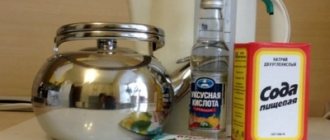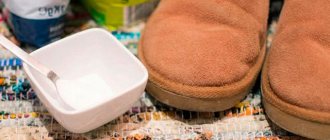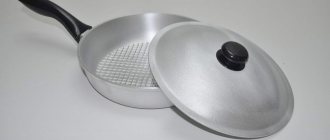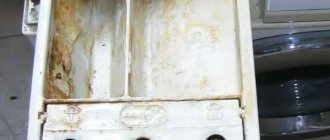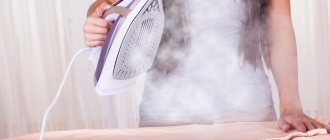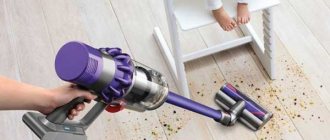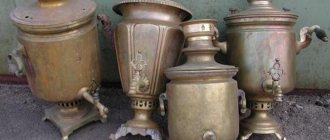When a kettle is used frequently, it constantly gets dirty, and even if you wash it regularly, it still loses its shine and looks worse each time.
If you forget the kettle on the stove while cooking, stains will appear on its outside due to splashes of grease and oil. Housewives with experience recommend using improvised means to clean the kettle, rather than store-bought ones, which have a high price. For example, a stainless steel kettle can be washed using soda, vinegar, activated carbon or citric acid. Non-standard methods include PVA glue and laundry soap. After reading this article, you will learn how to clean the kettle from grease from the outside - tips.
Dry mustard
Our grandmothers also knew how to clean grease from a kettle using mustard. Prepare the mixture by mixing a teaspoon each of dry mustard and granulated sugar. Add a little water to form something like a paste. Rub the sides of the dish and leave until dry. Then rub the equipment until shiny and rinse under running water. The same tool will help those who do not know how to clean carbon deposits from a kettle.
Process Details
Unusual cleaning options
If it was not possible to deal with the contamination using the methods described above, then you can try the following options:
- You will need a piece of laundry soap, which you need to grate and mix with PVA glue in the amount of two tablespoons. The resulting slurry should be filled with 3-4 liters of warm water. Boil the kettle in the resulting solution for 30 minutes and then rinse it. This is a good way to get rid of rust and oil stains.
An unusual way to clean a teapot is with cucumber pickle. It is suitable for cleaning a stainless steel kettle. Kitchen utensils are boiled in brine for half an hour and then washed under running water. After this treatment, a lot of salt will remain on the kettle, which can be washed off using any detergent.
- Mustard powder should also be applied to the surface of the kettle and left for 20 minutes, then rinsed.
How to clean grease from a metal kettle
The difficulty in cleaning aluminum cookware lies in its sensitivity to abrasives and poorly selected products.
For an aluminum kettle, you can use a mixture of vinegar and lemon juice. These substances are mixed in equal parts and added to water. For a regular-sized teapot, two tablespoons of both products are enough. The dishes are rubbed with the resulting mixture and left for 30 minutes, and then all dirt can be easily removed. An additional option is to apply any detergent to the surface, which can be left for 30-60 minutes. Then remove all dirt from the kettle and rinse the kettle with water.
How to clean grease from an enamel kettle
An enamel teapot is a rather demanding type of cookware. Not every product is suitable for cleaning it. For example, soda can damage the finish of the kettle. But it can also be used if you mix it with water and boil a kettle in it for about half an hour. After this, you need to cool the water and use a sponge to clean the kettle, from which all dirt should easily come off. To achieve an even greater effect, you can add a little detergent to the water when boiling.
Toothpaste is another excellent folk remedy. It is used to remove small greasy stains. An old toothbrush is suitable for this; apply the paste to the surface of the kettle, rubbing lightly. Then you just need to wash off the dirt with water and wipe it dry.
REFERENCE! A paste without a bleaching effect is most suitable for this, because it does not contain fine abrasives and it is not capable of damaging the surface of the kettle.
To clean the kettle, you can use a solution of table salt (2 tablespoons per liter of water), in which you need to boil it. After this treatment, oil stains will be removed much easier. This method can only be used for enamel teapots, since steel models may be damaged after such treatment.
Citric acid can also help remove fat. Powder in the amount of 1-2 tbsp. dissolve in a liter of water and place the dirty kettle there. The container with the kettle is boiled for 20-30 minutes and then left to cool. Then the kettle needs to be removed and washed with water.
Cleaning the glass surface of a teapot from grease
A glass teapot must be washed very carefully. Abrasives cannot be used in this case, because they will leave scratches on the surface. Household chemicals are suitable for this, for example, Cillit, Frosch, Schumanit. The main thing is that the product is in liquid or gel form. These products can only be applied to contaminated areas and only with gloves, so that the active substance affects the dirt and does not damage the surface. The product is left on the surface for 15-20 minutes and washed off first with warm and then with cold water. If this is necessary, then the kettle is boiled again so that it is cleaned not only outside, but also inside.
REFERENCE! Household chemicals are very toxic and when using them it is better to use gloves, as this can cause skin irritation.
In the future, it is best to place glassware away from cooking fatty foods. This is because high temperatures cause cracks in the surface due to hot oil splashing.
How to clean an electric kettle
Electric kettles can only be washed after they have been unplugged.
It is connected back to the cable only after the kettle is completely dry after washing. In order to remove dirt from plastic, products with an aggressive composition (soda or citric acid) are not suitable. If you find any carbonated drink in the house, then you don’t have to look for a cleaning product. It is better to choose soda without dyes, otherwise the light teapot may become stained.
Grease stains are treated with sparkling water and left for 30-60 minutes. After this, the dirt is wiped off with a sponge and washed off with water. Scale is also removed from the kettle using soda, which needs to be poured into the kettle and boiled. The cleansing effect is achieved with the help of acids that make up carbonated water.
Lemon is also used to clean an electric kettle; it only needs to wipe the surface. It helps remove fat and lighten yellow spots.
REFERENCE! Products in the form of tablets, powder or granules, which are sold in the store, are also suitable. They help remove more serious deposits.
Toothpaste
Check out another interesting way to clean the outside of a kettle. Apply the paste to a small brush and begin treating the dirty surface. After removing stains, rinse the dishes with water. Sour milk Few people know how to clean the outside of a metal kettle from grease using sour milk or kefir. It is better to use this product as soon as spots are noticed. Soak a cloth in milk and remove stains. Your dishes will return to their former shine and shine.
Tips for use
It is useful to know how and with what to clean an electric kettle from dirt, but what should you do so that you have to wash it as little as possible? To make the device less dirty, follow these rules:
- Care for the exterior surface regularly. Once every 2-3 days, wash the body of the kettle with a soft sponge and dishwashing detergent.
- Also rinse the inside, removing thin deposits with a sponge before it hardens.
- Once every two weeks, arrange preventative boiling with citric acid in a small concentration (for example, 5 g per 1 liter of water).
- After each use of the appliance, throw away any remaining water. Do not leave the kettle filled overnight.
- Pass water for boiling through a filter or settle.
- When choosing an electric kettle, remember that devices with a closed heating element have an advantage. They are easier to clean if necessary.
- If you place the kettle away from the stove and work surfaces, less grease and splashes will fall on it, which will have to be cleaned later.
Electric kettles
It is clear that boiling such a kettle in a cleaning solution will not work. Therefore, you will have to monitor his condition. Wipe the surface as often as possible, avoid heavy contamination. Remember that the kettle must be unplugged while washing. After wet treatment, wait until the surface is completely dry and only then turn on the device again.
If you need to remove scale from the inside, pour citric acid into the container or add a few tablespoons of vinegar. Boil the kettle, leave for 1-1.5 hours and rinse thoroughly. The described methods for cleaning the kettle from grease, burning and scale are effective and affordable. Use these methods, your dishes will always look decent.
The best descaling and soot removal products
The rating, based on an analysis of reviews, makes it easy to identify the best household chemicals.
- HG, according to consumers, is one of the most effective emulsions against severe scale. Among the advantages, cost-effectiveness comes first. One bottle with a capacity of 0.5 liters is enough to quickly and effectively completely remove even old limescale for a year. In addition, the liquid is absolutely safe and recommended for washing metal electric kettles and coffee makers.
- Bagi "Kumkumit" has long and firmly occupied a leading position in the ranking of highly effective household chemicals. The composition is based on a high concentration of citric acid. It copes well not only with lime deposits, but also with rust. A pleasant bonus is the “delicious” smell of lemon and freshness.
- "Cillit" is well known to all housewives. A universal gel based on oxalic acid quickly copes with all types of contamination. In addition, the manufacturer assures that the use of a cleaning product can increase the service life of a household appliance.
- “Cinderella Antiscale” is a domestic emulsion with a wide spectrum of action. Undoubted advantages: excellent combination of price and quality, versatility, lack of odor, effectiveness. The only negative is the prohibition on contact with the enamel surface.
Preparatory stage
Before cleaning a stainless steel kettle (as well as an electric or enameled one) from grease, scale and carbon deposits, decide on the required minimum:
- Sponges, soft rags. Never use metal brushes. Yes, they can clean stainless steel surfaces quite quickly, but the appearance of the kettle will deteriorate, grooves and scratches will appear on it, and this cannot be corrected. It’s not even worth talking about an enamel teapot - the enamel will come off instantly.
- A large basin that will fit your kettle. This is useful for soaking external surfaces.
- Gloves and cloth mask. They will definitely be needed for working with household chemicals and vinegar.
When everything you need is at hand, it’s time to take action.
What will happen to the electrical appliance?
Some dishwasher owners use their “home assistants” to the fullest. It’s amazing how they come up with this idea. Washed in the dishwasher:
- garden tools;
- rubber boots;
- raw root vegetables (mainly potatoes and carrots);
- plastic massage devices;
- chandelier details;
- elbow and knee pads;
- boxing gloves and mouth guards;
- helmets and leather gloves;
- umbrellas;
- flower pots and much more.
Exotic lovers even manage to cook food in the dishwasher.
If they even think about cooking food in a dishwasher, then why condemn those who think of stuffing electrical appliances into the washing chamber, in this case an electric kettle. From the point of view of experts, this should under no circumstances be done. There is a certain amount of electrics inside the kettle: a switch, an LED, several contacts, wires, a sensor. After washing the kettle in the dishwasher, we get this electric thing very wet.
Supporters of non-standard use of a dishwasher may reasonably note that the kettle can be thoroughly dried before use. That’s true, but when washing dishes, the kettle stays in a humid and warm environment for a long time. When exposed to moisture and detergents, metal contacts become covered with oxides, which can cause the kettle to fail.
Moisture can be removed by drying, but oxides can only be removed by cleaning the contacts. If after washing it is possible to completely disassemble the kettle, clean its contacts and carry out anti-corrosion treatment, then you can wash it. But if you do not intend to disassemble the kettle, then it is better not to put it in the dishwasher.
If the body of the kettle consists of plastic or ceramics, this is one thing, but if the kettle is metal, then corrosion can also affect the body. In this case, there is a high risk of losing the kettle. Don't take risks, clean electric kettles by hand.
Preparation for the procedure
Before proceeding directly to the procedure, it is necessary to take substances and prepare equipment in advance. To carry out the procedure you need:
- sponge or rag;
- latex gloves;
- a container of water into which the contaminated kettle will be completely placed.
When you need to decide exactly what to clean with, immediately take the necessary cleaning products.
Another important step in preparing the kettle for the cleaning procedure is soaking it. However, you need to be careful not to expose the dishes to temperature changes. The already cooled kettle needs to be soaked in water.
Precautionary measures
In order not to “treat” a burnt teapot, you must follow a number of simple rules:
- first pour water into the container, and only then put the kettle on the burner;
- do not leave any objects on the stove unattended;
- If you cannot accustom yourself to discipline, you will have to abandon stove-top models and use electric kettles with automatic shut-off.
We must remember that forgetfulness is dangerous and can result in serious problems (fire, smoke). Be careful and careful in everyday life, and then no force majeure will arise.
Recommendations
To ensure that stainless steel dishes have an attractive appearance and always remain clean, all you need to do is listen to a couple of useful tips that we will be happy to share:
- If someone in the family suffers from allergies, then it is better to abandon chemicals and use traditional methods.
- When using chemicals, do not forget about personal safety, use gloves and a respirator, carefully study the instructions and monitor the dosages of special equipment.
- Old stains are difficult to remove, so the best method to combat plaque and grease is to remove them regularly.
- To begin with, it is better to try the simplest and “softest” methods of removing fat and plaque. If they turned out to be ineffective, then you can move on to more serious methods, for example, the use of special equipment.
